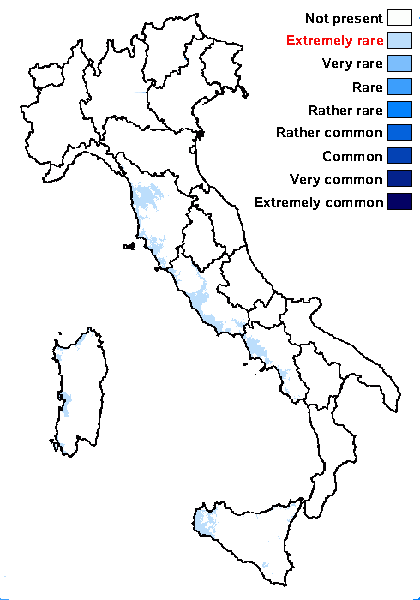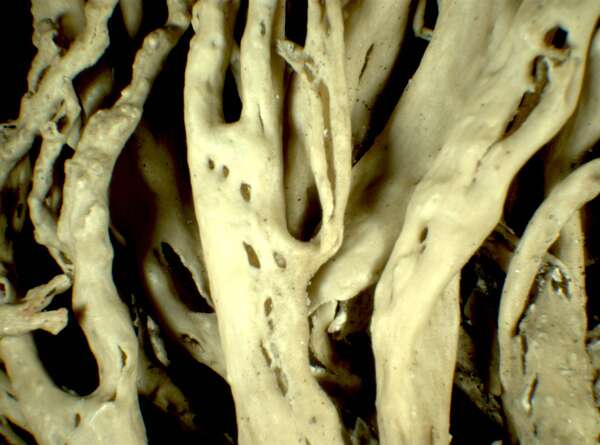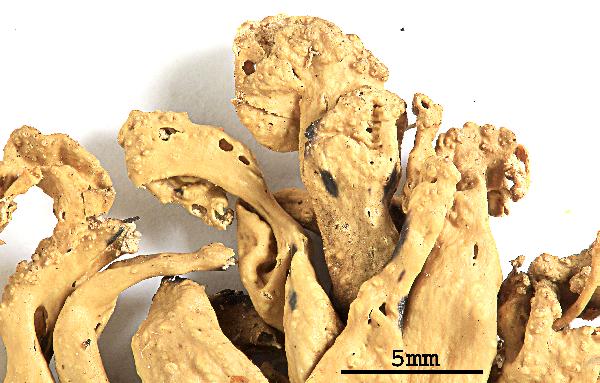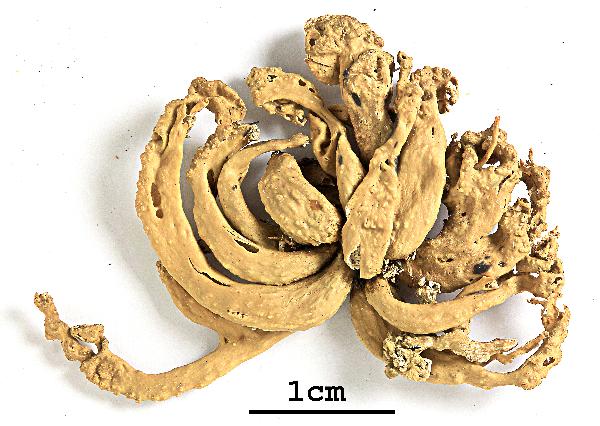Ramalina cribrosa De Not.
Giorn. Bot. Ital., 2, 1, 1: 213, 1846
Synonyms: Ramalina siliquosa auct. ital.
Distribution: C - Tosc, Laz (Gigante & Petriccione 1995), Sar (Monte 1993, Spjut & al. 2020). S - Camp, Si (Ottonello & Romano 1997, Ottonello & al. 2011).
Description: Thallus fruticose, pale yellowish green to greenish grey, matt, tufted, 5-15 cm tall, highly variable in shape (usually erect) consisting of inflated, (2-)4-10 mm wide, simple or very sparingly branched, pointed, more or less regular laciniae originating from a common holdfast, the surface usually richly fenestrate, exposing the hollow interior. Cortex 2-layered, the outer part paraplectenchymatous, the inner part with chondroid strands; medulla white, hollow, arachnoid near the cortex. Apothecia not observed. Photobiont chlorococcoid. Spot tests: cortex K-, C-, KC+ yellowish, P-; medulla K-, C-, KC-, P+ yellow to orange-red. Chemistry: cortex with usnic acid, medulla with protocetraric acid.Note: a Mediterranean species of coastal siliceous rocks; in Italy it is evidently rare and restricted to the Tyrrhenian region.
Growth form: Fruticose
Substrata: rocks
Photobiont: green algae other than Trentepohlia
Reproductive strategy: mainly sexual
Most common in areas with a humid-warm climate (e.g. most of Tyrrenian Italy)
Taxon bound to maritime-coastal situations
Commonnes-rarity: (info)
Alpine belt: absent
Subalpine belt: absent
Oromediterranean belt: absent
Montane belt: absent
Submediterranean belt: absent
Padanian area: absent
Humid submediterranean belt: absent
Humid mediterranean belt: extremely rare
Dry mediterranean belt: absent

Predictive model
Herbarium samples


P.L. Nimis; Owner: Department of Life Sciences, University of Trieste
Herbarium: TSB (10483)
2001/12/04
specimen corresponding to Ramalina cribrosa De Not.
Growth form: Fruticose
Substrata: rocks
Photobiont: green algae other than Trentepohlia
Reproductive strategy: mainly sexual
Most common in areas with a humid-warm climate (e.g. most of Tyrrenian Italy)
Taxon bound to maritime-coastal situations
Commonnes-rarity: (info)
Alpine belt: absent
Subalpine belt: absent
Oromediterranean belt: absent
Montane belt: absent
Submediterranean belt: absent
Padanian area: absent
Humid submediterranean belt: absent
Humid mediterranean belt: extremely rare
Dry mediterranean belt: absent

Predictive model
| Herbarium samples |


 INDEX FUNGORUM
INDEX FUNGORUM
 GBIF
GBIF



